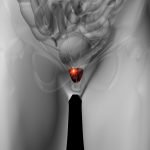Can Testosterone Therapy Benefit Hypogonadal Men?
Matthew Cavaiola, NMD, LAc
According to the Centers for Disease Control and Prevention,1 cardiovascular disease (CVD) is the overall leading cause of death in the United States, and more than half of 616 000 people who died of heart disease in 2008 were male. Of all the types of heart disease, coronary heart disease was the most prevalent.1
Cardiovascular disease has many origins throughout the human body, including the cardiovascular system, endocrine system, and immune system. Despite the influence that genetics has on the development of CVD, it is still considered a preventable condition. Most Americans have 1 or more of the following risk factors for developing heart disease, many of which are modifiable: physical inactivity, obesity, high blood pressure, cigarette smoking, high cholesterol level, and diabetes mellitus (DM). While these risk factors have been investigated thoroughly in the literature, the relationship among declining testosterone (T) levels, these same risk factors, and the incidence of CVD has not garnered the same attention.
Testosterone, the primary sex hormone found in men, has many important physiological functions such as wound and injury healing, red blood cell production, energy creation and capacity, and the development and maintenance of secondary sexual characteristics, as well as roles in muscle, tendon, and bone growth. Male hypogonadism or androgen deficiency, which has also been termed andropause or male menopause, represents a syndrome associated with deleterious physical and psychological changes that occur beginning at around age 35 years; T levels in men begin to decline by about 1% to 2% each year starting at this age.2 While these statistics are alarming, longitudinal investigations of individual men have shown the decline to be even more rapid, decreasing by about 1% higher per year.2 Symptoms associated with andropause include fatigue, low libido, erectile dysfunction, increase in fat mass, loss of muscle mass, decreased strength and response to exercise, anxiety, depression, insomnia, loss of focus and concentration, lack of motivation, and joint pain.
As men age and T levels decline, the risk for developing many chronic debilitating conditions subsequently increases. These diseases include osteoporosis, Alzheimer disease, DM, and CVD. It is unknown whether T deficiency can directly cause CVD or any of these other chronic illnesses; however, it is clear that male hypogonadism has a role in the decline of many different facets of metabolic and endocrine function that occur with age. The clustering of these metabolic risk factors, originally termed syndrome X and more commonly referred to as metabolic syndrome, is now thought to greatly increase the risk for developing arteriosclerotic CVD (ASCVD).3 Persons with metabolic syndrome have been shown to have at least a 2-fold increase in risk for developing ASCVD than those without, and the risk for developing type 2 DM (DM-2) increases by 5-fold in those with metabolic syndrome.4 According to the National Cholesterol Education Program Adult Treatment Panel III report,5 a diagnosis of metabolic syndrome can be made if a person has 3 or more of the following 5 features: (1) increased waist circumference (≥102 cm [40 in] in men and ≥88 cm [35 in] in women), (2) elevated triglycerides (TG) level (≥150 mg/dL or on drug treatment for elevated TG), (3) reduced high-density lipoprotein cholesterol (HDL-C) level (<40 mg/dL in men and <50 mg/dL in women or on drug treatment for reduced HDL-C), (4) elevated blood pressure (systolic ≥130 mm Hg or diastolic ≥85 mm Hg or on antihypertensive drug treatment in a patient with a history of hypertension), and (5) elevated fasting glucose level (≥100 mg/mL or on drug treatment for elevated glucose).
In their theoretical model, Traish et al6 postulated that androgen deficiency manifests in components of the aforementioned metabolic syndrome, including increased insulin resistance and glucotoxicity, greater visceral obesity, lipotoxicity, and production of inflammatory factors. All these factors could ultimately contribute to the resultant endothelial dysfunction and inherent changes that are the hallmark of CVD. Some of these alterations can include vasoconstriction of peripheral arteries and arterioles, arterial sclerosis, oxidative stress, thrombosis, inflammatory cell adhesion, smooth muscle proliferation, and endothelial permeability.6 In the next section of this article, we look more closely at the relationship between these metabolic cardiovascular risk factors and male hypogonadism.
Relationship Between Lipid Profiles and T Deficiency
Dyslipidemia, or abnormal amounts of lipids in the blood, has a central role in the development of metabolic syndrome and CVD. The factors that confer the greatest risk are elevated levels of total cholesterol (TC) and low-density lipoprotein cholesterol (LDL-C). An inverse association has also been demonstrated between the risk for CVD and the levels of HDL-C and its principal apolipoprotein A-1; elevated TG levels also are a predictor of both metabolic syndrome and ASCVD.7
Many studies have shown that reduced T levels are associated with increased TC, LDL-C, and TG levels, and several investigations have shown the benefit of T therapy in lowering both TC and LDL-C levels in men with hypogonadism. For instance, Swerdloff and Wang8 investigated TC, LDL-C, HDL-C, and TG levels in 52 hypogonadal men 60 years or older and in 119 hypogonadal men younger than 60 years. Both groups received T gel treatment for 180 days, and while both groups showed a marked reduction in TC, LDL-C, and TG levels, the older men demonstrated greater reductions across the board.8 Although controversial in the literature, a positive relationship has also been established between T level and HDL–C level. When men with prostate cancer were subjected to hormone-deprivation therapy, it was shown by multiple researchers that after just 3 months of treatment both TC and LDL-C levels were elevated; after a 2½-year course of androgen deprivation, levels of TG were markedly increased, and levels of HDL-C were substantially reduced. Therefore, antiandrogenic therapy contributes to ASCVD through changes in TC, LDL-C, and TG levels and a concomitant reduction in HDL-C level.
Relationship Among Insulin Sensitivity, DM-2, and T Deficiency
The prevalence of DM-2 has increased dramatically during the past 2 decades, with 6 million individuals having been diagnosed in 1980 and an astonishing 15 million in 2004. The incidence of DM-2, along with obesity, is expected to continue to rise exponentially in the next couple of decades. Several recent investigations indicate that the presence of metabolic syndrome is associated with at least a 2-fold increased risk for developing ASCVD and a 5-fold increased risk for developing DM-2. Once a patient has DM-2, the risk for ASCVD is enhanced; not only is the relative risk for coronary heart disease raised by 2-fold to 3-fold, but once coronary heart disease becomes manifest in a patient with DM, the prognosis for survival is greatly reduced.4
Evidence has shown that men with lower T levels are at greater risk for developing DM-2 and that low T levels may even predict the onset of DM-2. For example, a review and meta-analysis of 43 studies that included 6427 men by Ding et al9 demonstrated that men with higher plasma T levels had a lower risk for developing DM-2. A study by Simon et al10 showed that total T concentrations were significantly associated with fasting plasma insulin level, 2-hour plasma insulin levels, and glucose levels. Individuals with lower T levels had elevated insulin levels. With respect to the relationship between adiposity and T level, Osuna et al11 correlated waist circumference, body mass index, and insulin level to T levels. In each case, they found a negative correlation, suggesting that higher waist circumference and body mass index were associated with lower T levels.
When investigating whether T therapy can help androgen-deficient patients with DM, a group of researchers showed that after just 3 months of treatment men with DM had decreased fasting glucose, postprandial glucose, mean daily glucose, and glycated hemoglobin values compared with baseline.12 It was also demonstrated that T therapy may help insulin-dependent individuals reduce their insulin dosages after starting on treatment.12
The mechanisms by which higher glucose and insulin levels affect the hypothalamic-pituitary-gonadal axis and the secretion of T in men is not completely understood at this time. However, it has been postulated that Leydig cell function (the cells that produce T) may be impaired by changes in the production of hormones and cytokines locally in the target tissue and in adipose tissue.12 Moreover, T may have a direct effect on the pancreas and the insulin-secreting beta cells.12
Relationship Between Hypertension and T Deficiency
An estimated 68 million people in the United States have hypertension, and in 2008 high blood pressure was a primary or contributing cause of almost 350 000 deaths.13 The diagnosis of essential hypertension is made when the means of 2 or more systolic and diastolic blood pressure readings are at least 140 mm Hg or 90 mm Hg, respectively, at 2 or more subsequent office visits. Essential hypertension remains one of the most common modifiable risk factors for CVD, and it is known to cause a host of other serious health complications, including stroke, heart failure, and chronic renal failure.
There is a dearth of literature demonstrating causation of hypertension owing to hypogonadism in men. However, hypertension may be present in patients who often have some or all components of metabolic syndrome, including obesity. This makes it very difficult to dissect hypertension from other risk factors when attempting to determine whether T deficiency can directly cause hypertension. With that being said, endogenous T levels decline in andropause, and it has been shown that men older then 25 years with hypertension have lower T levels. One group of researchers showed that 9 months of T treatment reduced diastolic blood pressures significantly in abdominally obese men, and another study demonstrated significant reductions in both resting systolic and diastolic blood pressures during treatment with intramuscular T. Other research has shown similar favorable blood pressure–lowering effects of T therapy in middle-aged men.6
T Therapy
The components of metabolic syndrome, including dyslipidemia, hypertension, and uncontrolled blood glucose level, represent a small fraction of the multitude of physiological and metabolic processes that take place simultaneously to cause CVD. Cardiovascular disease continues to be the leading cause of death, and the number of men who experience both CVD and andropause continues to increase. However, the American Urological Association estimates that only about 10% of men with hypogonadism ever receive treatment.
Testosterone therapy has started to gain popularity among physicians to treat symptoms associated with andropause and to reduce the risk for the development of chronic illness. In combination with other naturopathic treatments and lifestyle modifications, T therapy should be considered to assist andropausal individuals with CVD. Based on the research described herein, T treatment may help lower TC and LDL-C levels, raise HDL-C level, improve insulin sensitivity and fasting glucose level, and stabilize both systolic and diastolic blood pressures. Bioidentical T therapy, usually in the form of testosterone cypionate, is most commonly used and is administered via daily application of transdermal creams, intramuscular injections every 7 to 14 days, or the implantation of subcutaneous pellets under the skin of the buttocks once every 3 to 6 months.
 Matthew Cavaiola, NMD, LAc, is both a naturopathic medical doctor and licensed acupuncturist in the state of Arizona. Before graduating from SCNM, Dr Cavaiola received his Bachelors of Arts in biological sciences and a Masters of Science in human nutrition from the University of Delaware. He also received a Masters of Science in acupuncture from the Phoenix Institute of Herbal Medicine and Acupuncture. Dr Cavaiola is passionate about treating many chronic conditions associated with the aging process at the Phoenix Anti-Aging Clinic. He specializes in treating chronic illness and uses hormone replacement therapy, clinical nutrition, IV nutritional therapy, acupuncture, and hyperbaric oxygen to help his patients. Dr Cavaiola also enjoys supervising medical students at SCNM and is an adjunct professor at Rio Salado College where he teaches Introduction to Human Nutrition.
Matthew Cavaiola, NMD, LAc, is both a naturopathic medical doctor and licensed acupuncturist in the state of Arizona. Before graduating from SCNM, Dr Cavaiola received his Bachelors of Arts in biological sciences and a Masters of Science in human nutrition from the University of Delaware. He also received a Masters of Science in acupuncture from the Phoenix Institute of Herbal Medicine and Acupuncture. Dr Cavaiola is passionate about treating many chronic conditions associated with the aging process at the Phoenix Anti-Aging Clinic. He specializes in treating chronic illness and uses hormone replacement therapy, clinical nutrition, IV nutritional therapy, acupuncture, and hyperbaric oxygen to help his patients. Dr Cavaiola also enjoys supervising medical students at SCNM and is an adjunct professor at Rio Salado College where he teaches Introduction to Human Nutrition.
References
- Centers for Disease Control and Prevention. Heart disease facts. http://www.cdc.gov/heartdisease/facts.htm. Accessed September 19, 2012.
- Travison TG, Araujo AB, Hall SA, McKinlay JB. Temporal trends in testosterone levels and treatment in older men. Curr Opin Endocrinol Diabetes Obes. 2009;16(3):211-217.
- Isomaa B, Almgren P, Tuomi T, et al. Cardiovascular morbidity and mortality associated with metabolic syndrome. Diabetes Care. 2001;24(4):683-689.
- Grundy SM. Obesity, metabolic syndrome, and cardiovascular disease. J Clin Endocrinol Metab. 2004;89(6):2595-2600.
- National Cholesterol Education Program (NCEP) Expert Panel on Detection, Evaluation, and Treatment of High Blood Cholesterol in Adults (Adult Treatment Panel III). Third Report of the National Cholesterol Education Program (NCEP) Expert Panel on Detection, Evaluation, and Treatment of High Blood Cholesterol in Adults (Adult Treatment Panel III) final report. Circulation. 2002;106(25):3143-3421.
- Traish AM, Saad F, Feeley RJ, Guay A. The dark side of testosterone deficiency, III: cardiovascular disease. J Androl. 2009;30(5):477-494.
- Leon AS. Dislipidemia and risk of coronary heart disease: role of lifestyle approaches for its management. Am J Lifestyle Med. 2009;3(4):257-273.
- Swerdloff RS, Wang C. Three-year follow-up of androgen treatment in hypogonadal men: preliminary report with testosterone gel. Aging Male. 2003;6(3):207-211.
- Ding EL, Song Y, Malik VS, Liu S. Sex differences of endogenous sex hormones and risk of type 2 diabetes: a systematic review and meta-analysis. JAMA. 2006;295(11):1288-1299.
- Simon D, Charles MA, Nahoul K, et al. Association between plasma total testosterone and cardiovascular risk factors in healthy adult men: the Telecom Study. J Clin Endocrinol Metab. 1997;82(2):682-685.
- Osuna JA, Gómez-Pérez R, Arata-Bellabarba G, Villaroel V. Relationship between BMI, total testosterone, sex hormone–binding—globulin, leptin, insulin and insulin resistance in obese men. Arch Androl. 2006;52(5):355-361.
- Traish AM, Saad F, Guay A. The dark side of testosterone deficiency, II: type 2 diabetes and insulin resistance. J Androl. 2009;30(1):23-32.
- Centers for Disease Control and Prevention. High blood pressure facts. http://www.cdc.gov/bloodpressure/facts.htm. Accessed September 19, 2012.










